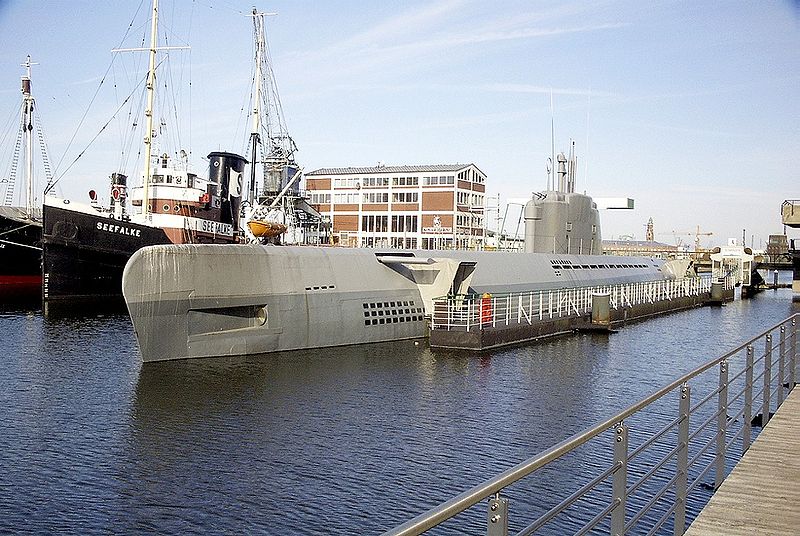
“Today, only five U-boats remain and four of them are open to the public. So where can you visit these fascinating relics?”
GERMANY PUT NEARLY 1,250 U-boats to sea in World War Two. Of those, nearly 800 were destroyed by Allied ships and aircraft, 220 were intentionally scuttled by their crews at war’s end, 156 were handed over to the British and Americans on VE-Day (116 of those were later sent to the bottom), 50 were declared missing and six were captured in action. Today, only five U-boats remain and four of them are open to the public. So where can you visit these fascinating relics? Read on.

U-505
The Chicago Museum of Science and Industry has been home to the U-505, a Type IXC U-boat, since 1954. The vessel was seized by the USS Chatelain on June 4, 1944 off the coast of West Africa. After its capture, the 505 remained with the U.S. Navy until it was donated to the Chicago museum. It’s been on display there to this day. Visitors can peruse the larger U-boat exhibit as part of the museum’s general admission, but a 15-minute stem-to-stern tour of the interior of the 505 costs an additional $8. Special two-and-a half hour, in-depth tours are available on select weekends throughout the year. Still a very popular attraction, the museum recommends visitors buy passes to the on-board tour online in advance and to try to visit early in the day or on Mondays and Tuesdays to avoid the crowds.
http://www.msichicago.org/whats-here/exhibits/u-505/

U-995
Those visiting Kiel, Germany can board and tour the U-995, a completely intact Type VIIC/41 U-boat. From September of 1943 to the end of the war, the 220-foot vessel conducted several patrols, sinking a total of nine enemy ships, including two warships. After surrendering to the British in Norway at war’s end, the U-955 went on to serve in the Norwegian navy until 1971, when she was donated to Germany as a museum piece. Norway charged Germany a single Deutsche Mark for the 995. For the past 40 years, the U-boat has sat at the waters edge delighting visitors.
http://www.deutscher-marinebund.de/u995_geschichte.htm

U-2540
One of Germany’s last U-boats to be built, the U-2540 was scuttled before she could see action. A Type XXI, the 2540 was commissioned in late February, 1945. Fuel shortages prevented the 251-foot U-boat from sailing into battle – instead she was sent to the bottom of the Baltic on May, 4, 1945. Salvaged in 1957, she was restored and served as a research sub in the post-war German navy and finally decommissioned in 1982 after a collision with a destroyer. The new owners, the German Maritime Museum, converted the ship back to her wartime configuration and since 1984 have opened the 2540 to the public at Bremerhaven, Germany.
www.dsm.museum

U-534
Visitors to Liverpool, England can get up close and personal with the remains of U-534, a Type IXC/40, which was sunk in the closing days of the war. Mystery surrounded the motives of the U-534 skipper who ignored orders from the Kreigsmarine to surrender his vessel to the Allies and instead steamed out to the open sea. That’s when she was spotted and attacked by a RAF B-24 bomber. The vessel sunk and remained undisturbed for 41 years until a Danish salvager discovered the wreckage. Many speculated that the boat might have been trying to escape with Nazi gold and that a fortune was waiting in her hull. Such rumours proved false when the 534 was raised in 1996. The U-boat first went on display in Birkenhead England as part of the Warship Preservation Trust. When the foundation went bust in 2006, she was transferred to the Liverpool ferry authority. The main hull of the boat was split into sections and is now displayed in separate segments in a large open air waterfront park on the Mersey River. A replica of conning tower and a U-boat museum complete the exhibit, which is open daily. Admission is £6 for adults and £3 for children.
http://www.u-boatstory.co.uk/
(originally published May 16, 2012)












Hi, you mentioned there was a 5th submarine boat that is not open to the public, do you know where it is? Or, who owns it? I look forward to hearing your reply! Thanks
I tried to find my old notes for the article… it was published four years ago. Still looking. I *think* there is one in Germany that is sealed.
I believe it is a memorial for the u boat crews at Flensberg.
It is a shame that the US Navy thought it was better to junk sink the U-Boats, rather than keep them for historic value.
I think that, at the end of a terrible war such as WWII, no one was really thinking of “historic” value, they just wanted to put it all behind them. I must admit to not understanding why they weren’t used for the steel in them though. A lot of steel at the bottom of the Atlantic that could have been recycled. Of course, maybe the idea of recycling wasn’t on anyone’s minds at that time.
Maybe I’m wrong but wasn’t U-605 a Type VII C bpat?
You’re right. We checked. But U505 isn’t.
There is another U-Boat in South America held onshore by a German collector and three more in the damaged and sealed U boat pens in a German port city. Of course there are several more at the bottom of the ocean including off of the South Carolina coastline.
The Type 11’s were very sophisticated, they look like modern subs. I always thought it was a very good thing that the Germans never had the capability to mass produce like the USA did.
The Museum in Chicago is named the Museum of Science and Industry, not “Technology,” as your article says. You need to correct that.
I’ve heard about three scuttled type 2s somewhere off the Turkish coast, all used with some success by Germany against the Russians. Wonder if any might be salvageable?
I’m not sure what is wrong, bt U2540/U2450 has both numbers in tyhe article.
Nice catch. Thanks.